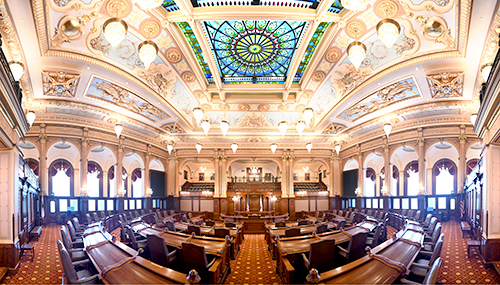
Introduction of Bills
Only legislators may introduce bills. After a bill is introduced, it is printed and sent to a committee for a hearing.
Committee Action
At the committee hearing, citizens may appear and give their views for or against a bill. The committee may recommend that a bill “do pass” or “do not pass.”
Three Readings
Each bill must be read by title on three different days in both the House and Senate before it is passed. In practice, the readings mark key stages in the movement of a bill from introduction to passage.
Amendments to Bills
When a bill is called for its second reading, amendments (changes in wording) previously approved by a standing committee, are adopted. Amendments can be offered by any member, but are usually referred to a standing committee for consideration.
Passage of Bills
When a bill is called for its third reading, it is voted on for passage. A roll call vote is required, and a majority of the members elected must vote “Yes” to pass a bill, 30 votes in the Senate; 60 votes in the House.
Governor’s Action
Before a bill becomes law, it must be presented to the governor. He may sign a bill into law or send it back to the legislature for changes. He also may veto or reduce an appropriation item, or he may veto the entire bill.
Override of Governor’s Vetoes
The legislature may agree or disagree with the governor’s changes or veto of bills. If the legislature disagrees, it has the power to override the governor’s changes.













 © 2025 Illinois Senate Democratic Caucus
© 2025 Illinois Senate Democratic Caucus